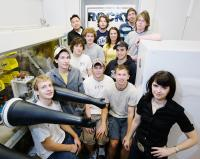Aug 3 2007
One of the fundamental challenges facing organic synthesis in the 21st century is the need to significantly increase the efficiency with which carbon frameworks can be constructed and functionalized. Chemists at the University of Illinois are helping to meet this challenge by developing a class of carbon-hydrogen catalysts that are highly selective, reactive and tolerant of other functionality.
 M. Christina White, right, a professor of chemistry, led the group that developed a class of carbon-hydrogen catalysts that are highly selective, reactive and tolerant of other functionality.
M. Christina White, right, a professor of chemistry, led the group that developed a class of carbon-hydrogen catalysts that are highly selective, reactive and tolerant of other functionality.
The catalysts also offer a new strategy for streamlining the synthesis of important compounds, including drugs and pharmaceuticals, by avoiding the functional group manipulations required for working with oxidized materials.
"We are creating a toolbox of catalytic reactions that allow us to go directly from a carbon-hydrogen bond to a carbon-oxygen bond or to a carbon-nitrogen bond," said M. Christina White, a professor of chemistry at Illinois. "By offering fewer steps, fewer functional group manipulations and higher yields, this toolbox will change the way chemists make molecules."
Currently, chemists must make molecules by beginning with something that is already oxidized. But, having to start with that functionality means it must be carried " and protected " throughout the entire synthetic sequence. And that costs reagents, time, money and manpower, in addition to being inherently inefficient.
"Unlike standard synthetic methods, we don't have to carry the functionality throughout the entire sequence," White said. "Instead, we carry latent functionality as a carbon-hydrogen bond. Then, at a late stage in the synthesis, we remove the hydrogen and replace it with oxygen or nitrogen - right where we need it for the next chemical reaction."
In the June 13 issue of the Journal of the American Chemical Society, White and graduate student Kenneth J. Fraunhoffer describe the catalytic pathway they used to synthesize a derivative of the chemotherapeutic reagent acosamine. They were able to eliminate all of the functional group manipulations and cut by one-half the number of steps required, while maintaining the same purity and yield.
White has also used her catalyst to streamline the synthesis of a peptidase inhibitor drug candidate, a nucleotide-sugar L-galactose, and is currently working on the antibiotic erythromycin A.